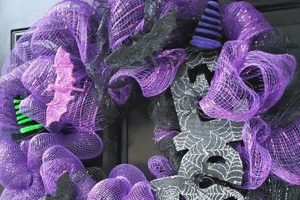The construction of arboreal representations from timber, undertaken as a do-it-yourself project, constitutes a popular crafting activity. These projects range from small decorative items suitable for tabletop display to larger, more elaborate structures intended for seasonal ornamentation or year-round artistic expression. For instance, a miniature version crafted from reclaimed pallet wood can serve as a rustic holiday centerpiece.
The appeal of such endeavors stems from multiple factors, including cost-effectiveness, customization potential, and the satisfaction derived from creating a unique object. Historically, crafting tree-like objects from wood has been a tradition in various cultures, often associated with seasonal celebrations and symbolic representations of nature. The practice allows individuals to engage with natural materials and express their creativity in tangible form.
The subsequent sections will explore diverse techniques for constructing these timber-based arboreal forms, encompassing material selection, design considerations, assembly methods, and finishing options. Furthermore, variations in style and purpose will be examined, providing a comprehensive guide to realizing individualized projects.
Essential Guidance for Timber Arboreal Construction
The following recommendations are designed to optimize the creation process and ensure a successful outcome when undertaking timber arboreal construction. Adherence to these guidelines will enhance both the structural integrity and aesthetic appeal of the finished product.
Tip 1: Material Selection: Employ kiln-dried lumber to minimize warping and cracking. Softwoods, such as pine or cedar, are easier to work with for intricate designs, while hardwoods, like oak or maple, provide greater durability for larger structures.
Tip 2: Precise Measurement and Cutting: Prior to assembly, meticulously measure and cut all components to ensure proper alignment and structural stability. Inaccurate cuts can compromise the overall design and necessitate corrective measures.
Tip 3: Secure Fastening Techniques: Utilize appropriate fasteners, such as wood screws or dowels, in conjunction with wood glue to create robust joints. The selection of fastener should be based on the material thickness and the anticipated load bearing requirements.
Tip 4: Gradual Assembly: Construct the structure in a sequential manner, starting with the base and proceeding upwards. This methodical approach facilitates accurate alignment and minimizes the risk of structural instability during the assembly process.
Tip 5: Sanding and Surface Preparation: Before applying any finish, thoroughly sand all surfaces to remove imperfections and create a smooth substrate. Proper surface preparation is crucial for achieving a uniform and aesthetically pleasing finish.
Tip 6: Finishing Application: Apply a protective finish, such as paint, stain, or varnish, to enhance the aesthetic appeal and protect the wood from environmental factors. Multiple thin coats are preferable to a single thick coat for optimal results.
Tip 7: Safety Precautions: Always wear appropriate safety gear, including eye protection and a dust mask, when working with power tools or applying finishes. Ensure adequate ventilation to minimize exposure to harmful fumes.
Implementing these recommendations promotes project longevity and amplifies the visual characteristics. It empowers the crafter to produce a project of remarkable quality.
The succeeding segments will investigate typical issues and proposed remedies, assuring project robustness and inventive methods.
1. Material Selection
The choice of material directly impacts the structural integrity, aesthetic appeal, and longevity of a timber arboreal construction. The properties inherent to different wood types dictate their suitability for specific design parameters. For instance, a project featuring intricate, delicate branches necessitates a wood with fine grain and minimal splintering, such as basswood or poplar. Conversely, a larger, more robust construction designed for outdoor display demands a weather-resistant species like cedar or treated pine. Inadequate material selection can lead to structural failure, premature decay, or an undesirable aesthetic outcome, rendering the project unsuccessful. A softwood used in a high-stress application will likely warp or break, while a hardwood lacking proper treatment will be susceptible to moisture damage and insect infestation.
Beyond structural considerations, the selected material influences the visual characteristics. The grain pattern, color, and texture of the wood contribute significantly to the overall aesthetic. Reclaimed lumber, for example, introduces a rustic, aged appearance, whereas a highly polished hardwood offers a more refined, contemporary look. The ease with which a wood accepts paint, stain, or other finishes is also a crucial factor. Some species, such as maple, require extensive preparation to achieve an even finish, while others, like pine, readily absorb treatments. Thus, the intended aesthetic and finishing techniques should inform the selection process. Consider a project intending to replicate the appearance of aged driftwood; using naturally weathered barn wood would be far more effective than attempting to artificially age a piece of new lumber.
In summary, material selection constitutes a fundamental determinant of project success in timber arboreal construction. Failure to carefully consider the structural requirements, aesthetic goals, and finishing techniques can compromise the integrity and visual appeal of the final product. While experimentation with different wood types is encouraged, a thorough understanding of their respective properties is essential for achieving the desired outcome. The optimal choice aligns with both the artistic vision and the practical demands of the project, resulting in a creation that is both visually pleasing and structurally sound.
2. Design Complexity
Design complexity, in the context of timber arboreal construction, refers to the intricacy and sophistication of the tree representation being fabricated. It influences multiple facets of the project, from material requirements and tool utilization to the required skill level and time investment. Increased design complexity typically correlates with higher material consumption, the need for specialized tools, and a more skilled artisan. A simple, stylized tree outline requires minimal material and basic cutting tools, whereas a realistic representation with intricate branching patterns demands substantial timber resources, advanced carving implements, and considerable expertise. Failure to accurately assess and manage design complexity can lead to project abandonment, structural instability, or a final product that deviates significantly from the intended vision. For example, a novice attempting to replicate a highly detailed, multi-layered tree design without sufficient experience is likely to encounter significant challenges and produce a substandard result.
The level of design complexity directly affects the selection of appropriate construction techniques. Basic designs may employ simple butt joints and glue for assembly, while more intricate structures necessitate the use of advanced joinery methods, such as mortise and tenon or dovetail joints, to ensure structural integrity. Moreover, complex designs often involve the incorporation of curved or sculpted elements, requiring the utilization of specialized carving tools and shaping techniques. A design featuring numerous small branches demands precise cutting and careful assembly to prevent breakage or misalignment. Conversely, a simpler design allows for the use of more forgiving techniques and reduces the risk of structural failure. Consider a project involving the creation of a miniature forest scene; the individual trees within the scene may range from simple geometric shapes to detailed representations, each requiring a different level of skill and technique.
In conclusion, understanding and managing design complexity is crucial for the successful execution of a timber arboreal project. A realistic assessment of one’s skill level, the available tools and resources, and the time commitment required is essential for selecting a design that is both achievable and satisfying. While ambitious designs can be rewarding, it is often prudent to start with simpler projects and gradually increase complexity as skills and experience develop. The ultimate goal is to create a visually appealing and structurally sound piece that reflects the individual’s creativity and craftsmanship, regardless of its inherent complexity.
3. Tools and Techniques
The successful realization of a timber arboreal project, often referred to as a “wooden tree diy,” is inextricably linked to the appropriate application of specific tools and techniques. The effectiveness of material manipulation, joint creation, and finishing processes hinges on the selection and skillful deployment of implements and methods designed for woodworking. The causal relationship is evident: inadequate tooling or improper technique directly results in flawed construction, compromised structural integrity, and diminished aesthetic quality. For example, attempting to cut intricate curves in hardwood using a dull hand saw leads to splintering, imprecise lines, and increased physical exertion, whereas a bandsaw equipped with a sharp blade and operated with proper technique yields clean, accurate cuts with minimal effort.
The importance of appropriate tools and techniques extends beyond mere efficiency; it is fundamental to the integrity of the finished product. A poorly executed joint, irrespective of the quality of the materials used, weakens the overall structure and renders it susceptible to failure. Techniques such as mortise and tenon or dovetail joints, when implemented correctly using chisels, saws, and marking gauges, create robust connections capable of withstanding significant stress. Similarly, proper sanding and finishing techniques, employing progressively finer grits of sandpaper and applying multiple thin coats of sealant, result in a smooth, durable surface that enhances the visual appeal and protects the wood from environmental degradation. Consider the construction of a small, decorative wooden tree intended for outdoor display; without appropriate weather-resistant sealant applied using correct spray painting techniques, the wood will succumb to moisture damage and rot.
In summary, the harmonious interplay between tools and techniques dictates the success of any “wooden tree diy” undertaking. Mastery of fundamental woodworking skills, coupled with the judicious selection and responsible use of tools, ensures a robust, aesthetically pleasing final product. The challenges inherent in such projects often stem from a lack of familiarity with specific techniques or a reliance on inadequate tools. Addressing these deficiencies through education and investment in appropriate equipment is essential for realizing the full potential of timber arboreal construction.
4. Finishing Methods
The application of finishing methods to timber arboreal construction projects constitutes a crucial stage directly influencing the longevity, aesthetic quality, and overall appeal of the creation. These techniques, often applied to a “wooden tree diy” endeavor, serve to protect the wood from environmental factors, enhance its visual characteristics, and provide a durable surface. The selection of an appropriate finishing method directly determines the project’s resistance to moisture, ultraviolet radiation, and physical wear, ultimately affecting its lifespan. For example, a wooden tree intended for outdoor display necessitates a weather-resistant sealant, such as spar varnish or exterior paint, to prevent rot and decay. The absence of such protection renders the wood vulnerable to the elements, leading to premature deterioration.
Furthermore, finishing methods significantly contribute to the visual appeal of a “wooden tree diy” project. Staining techniques can accentuate the natural grain of the wood, providing a rich, warm tone. Painting allows for the incorporation of color and artistic expression, transforming the project into a vibrant decorative piece. Clear finishes, such as polyurethane or lacquer, offer protection while preserving the wood’s natural color and texture. The choice of finish should align with the intended aesthetic and the overall design of the project. A rustic, farmhouse-style wooden tree might benefit from a distressed paint finish, while a more contemporary design could be enhanced with a sleek, glossy lacquer. Improper application of finishing materials, such as uneven staining or brushstrokes in paint, can detract from the visual quality of the project and undermine the overall craftsmanship. This is why, as a practical application, the finishing step should begin with a test sample to achieve the desired effect and consistency before applying it to the final wooden tree.
In summary, the connection between finishing methods and “wooden tree diy” is fundamental to the success of any timber arboreal construction endeavor. Selection of the appropriate finish is a critical component and should consider both the environmental factors to which the creation will be exposed and the projects desired aesthetic. Challenges in this stage often arise from improper application techniques or the selection of an unsuitable finish for the chosen wood or design. A thorough understanding of available finishing options and their properties, combined with careful execution, ensures the creation of a durable, visually appealing, and long-lasting timber arboreal project.
5. Structural Integrity
Structural integrity, in the context of “wooden tree diy” projects, refers to the ability of the completed structure to withstand applied forces and maintain its intended form and function over time. This characteristic is paramount, dictating both the safety and longevity of the creation. A failure in structural integrity can manifest as warping, cracking, joint separation, or complete collapse, rendering the project unusable or even hazardous. The underlying cause of such failures often stems from inadequate design, improper material selection, flawed construction techniques, or environmental exposure. For instance, a large wooden tree intended for outdoor display, constructed with insufficient bracing and using untreated softwood, is highly susceptible to wind damage, moisture absorption, and eventual structural failure. Conversely, a well-designed and meticulously constructed tree, utilizing durable materials and secure joinery, exhibits enhanced resistance to external stresses and environmental factors.
The practical significance of understanding structural integrity in “wooden tree diy” projects lies in the ability to proactively mitigate potential risks and optimize the design for durability. Key considerations include load-bearing capacity, joint strength, material properties, and environmental conditions. Calculating the anticipated weight distribution and wind resistance is essential for ensuring the stability of larger structures. Selecting appropriate joinery methods, such as mortise and tenon or dovetail joints, provides enhanced structural support compared to simple butt joints. The choice of wood species also plays a crucial role, with hardwoods generally offering greater strength and resistance to decay than softwoods. Furthermore, applying protective coatings and sealants can shield the wood from moisture, ultraviolet radiation, and insect infestation, thereby prolonging its lifespan. As a clear example, carefully chosen wood screws and appropriate wood glue help to secure each piece of the wood tree to create rigidness and ensure the long-term structure. Any weakness of this section directly results in a failed wooden tree diy.
In conclusion, structural integrity represents a cornerstone of successful “wooden tree diy” projects. A comprehensive understanding of the factors influencing structural stability, coupled with diligent design and construction practices, is essential for creating safe, durable, and aesthetically pleasing timber arboreal structures. Challenges in achieving optimal structural integrity often arise from a lack of planning, cost-cutting measures that compromise quality, or inadequate woodworking skills. Overcoming these challenges requires a commitment to thorough research, careful material selection, and meticulous execution, ultimately resulting in a creation that withstands the test of time and fulfills its intended purpose.
Frequently Asked Questions Regarding Timber Arboreal Construction
The following section addresses common inquiries and misconceptions concerning the process of constructing tree-like forms from wood, often referred to as “wooden tree diy” projects. These answers aim to provide clarity and guidance for individuals undertaking such endeavors.
Question 1: What type of wood is most suitable for “wooden tree diy” projects intended for outdoor display?
Species exhibiting natural resistance to decay and insect infestation are recommended. Cedar, redwood, and treated pine offer superior durability compared to non-treated softwoods. The selection should also consider the aesthetic preferences and finishing options compatible with the chosen wood.
Question 2: How can warping and cracking be minimized in timber arboreal constructions?
Employing kiln-dried lumber is crucial, as it reduces the moisture content and minimizes dimensional changes. Additionally, sealing the wood with a protective finish and avoiding exposure to extreme temperature fluctuations can mitigate warping and cracking.
Question 3: What are the essential tools required for undertaking “wooden tree diy” projects involving intricate designs?
A bandsaw, coping saw, and carving chisels are necessary for creating complex shapes and details. A drill with various bits, a sander, and measuring instruments are also essential for precise assembly and finishing.
Question 4: How can structural integrity be ensured in large “wooden tree diy” constructions?
Employing robust joinery techniques, such as mortise and tenon or dovetail joints, is critical for creating strong connections. Internal bracing and reinforcement can further enhance stability, particularly in areas subject to significant stress.
Question 5: What safety precautions should be observed when working on “wooden tree diy” projects involving power tools?
Eye protection, hearing protection, and a dust mask are mandatory. Ensure adequate ventilation to minimize exposure to sawdust and fumes. Familiarize yourself with the operating instructions for each tool and exercise caution at all times.
Question 6: What finishing options are available for “wooden tree diy” projects, and how do they differ?
Paint provides color and protection, while stain enhances the natural grain of the wood. Varnish offers a durable, glossy finish, and oil-based sealants provide moisture resistance. The choice depends on the desired aesthetic and the intended use of the project.
These answers provide a foundation for informed decision-making in timber arboreal construction. Careful consideration of these factors contributes to the successful completion of durable and aesthetically pleasing projects.
The subsequent section will offer advanced techniques for further refining “wooden tree diy” skills.
Concluding Remarks on Timber Arboreal Construction
The preceding exploration of “wooden tree diy” projects has underscored the multifaceted nature of this craft. From material selection and design considerations to structural integrity and finishing methods, success hinges on a comprehensive understanding of woodworking principles and diligent execution. The creation of durable, aesthetically pleasing timber arboreal structures demands careful planning, skillful application of techniques, and a commitment to quality.
As individuals continue to engage with “wooden tree diy”, a continued focus on sustainable practices and innovative design approaches will be paramount. Further advancements in woodworking techniques and material science promise to unlock new possibilities, allowing for the creation of ever more intricate and enduring timber arboreal forms. The pursuit of excellence in this craft ultimately contributes to a deeper appreciation of the inherent beauty and versatility of wood as a medium for artistic expression.







